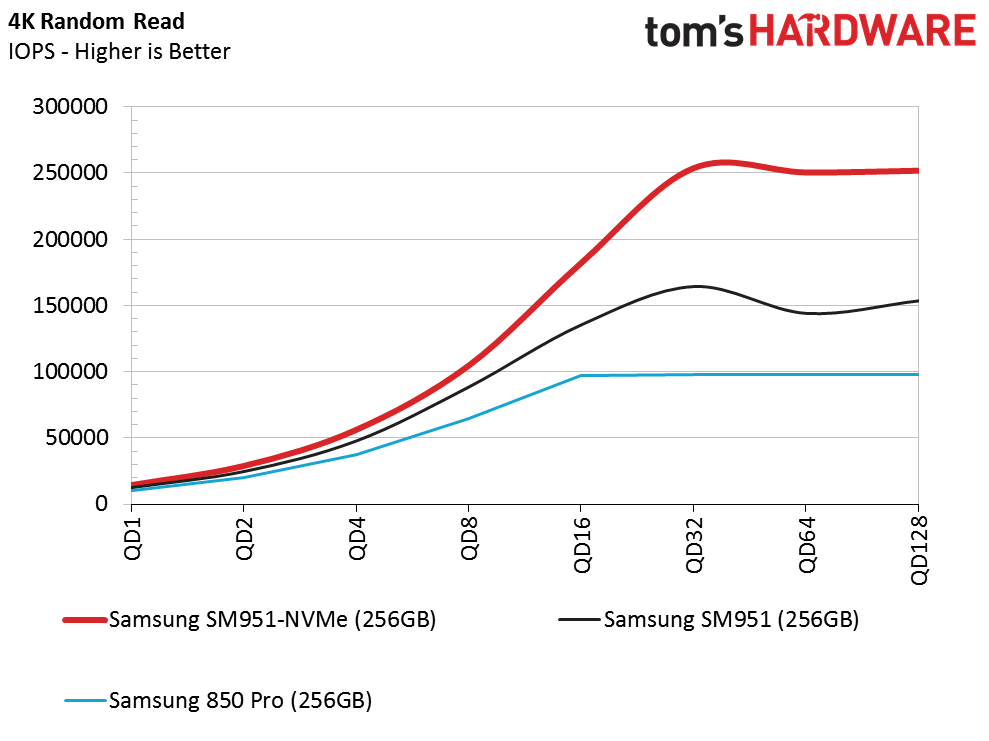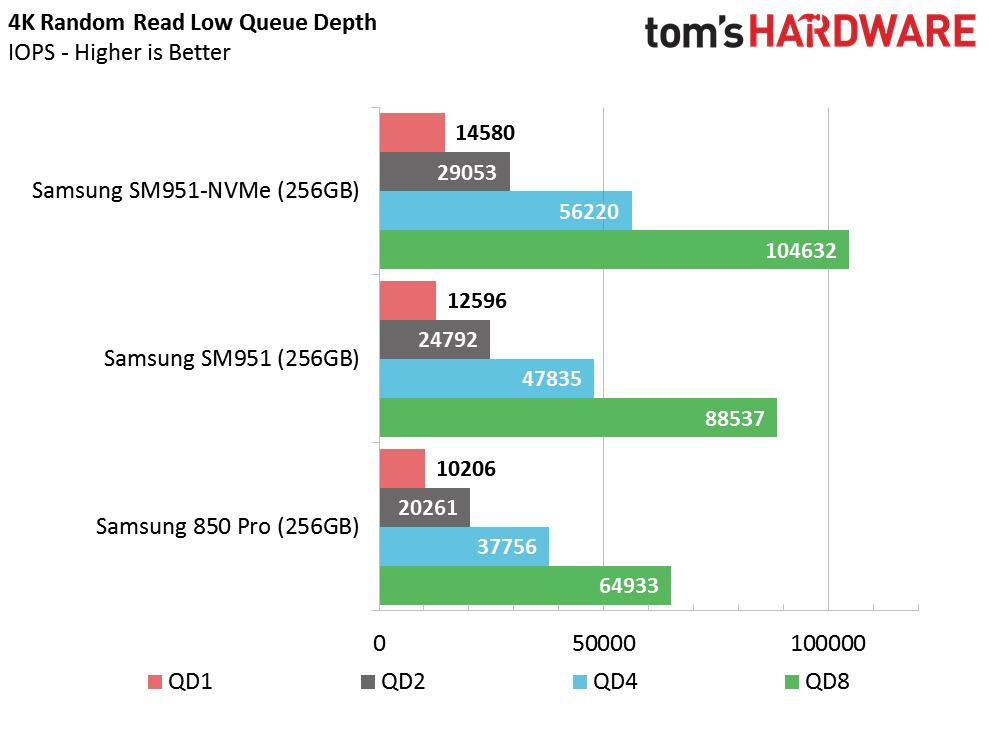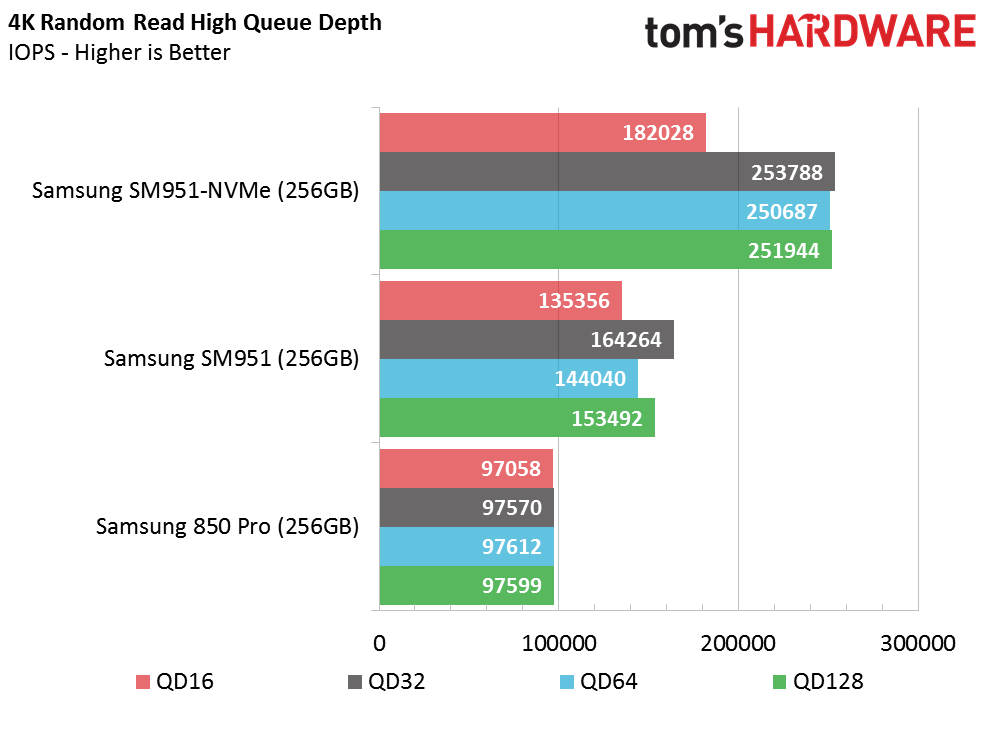Samsung SM951-NVMe Versus AHCI Versus SATA 850 Pro
Why you can trust Tom's Hardware
Random Read



Since NVMe helps reduce latency, it shouldn't come as a surprise to see the largest gains coming from random access patterns. Again, Samsung's 1xnm MLC flash is fast enough while reading data to demonstrate the benefit of NVMe. The SM951-NVMe 256GB SSD reaches just over 250,000 IOPS before leveling off. With the same controller and flash, but the older AHCI protocol, the SM951 256GB is down by nearly 100,000 peak random read IOPS.
Of course, peak performance is interesting. But most of us will notice the additional performance at lower queue depths. At QD1, the NVMe model delivers around 2000 more random read IOPS, which is equivalent to a typical SSD product cycle speed-up. Those usually happen each year. But Samsung is delivering a generational upgrade in just a few months.
Comparing the SM951-NVMe to the 850 Pro, we see the equivalent of a two-generation increase at low queue depths. Most users spend 80% of their time reading data and around 20% writing it. Those requests are typically random in nature. Given both stipulations, you're looking at a very large performance boost over the 850 Pro.
We were able to reach Samsung's claimed 300,000 random read IOPS by changing the parameters of our test. In order to do so, we had to mimic enterprise-class benchmarking, veering away from our consumer workloads.
Get Tom's Hardware's best news and in-depth reviews, straight to your inbox.

Chris Ramseyer was a senior contributing editor for Tom's Hardware. He tested and reviewed consumer storage.
-
Amdlova hpv-2560 is rated 1.9A and the another one VPV-2560 is 2.7A Maybe you guys need test the power consumption.Reply -
atheus I find the preamble about comparing these M.2 drives to regular SATA drives a little odd. When SSD's first came out, of course they were compared to HDD's because that was precisely the question of the moment — how much more performance can one expect from the more expensive SSD's. With this new generation of SSD's, it's only natural to want to see them compared to the old, cheaper stuff. How else are we going to evaluate whether it's worth it to upgrade?Reply
If it only resulted in an extra 10% on a real-world test, then it wouldn't make any sense to spend double or more on a NVMe drive. With these solid numbers, though, the massive performance leap will be well worth the cost for those who can afford it. -
TechyInAZ Looks great! NVMe is defiantly the ideal solution for users that need high speed/responsive storage.Reply
I wish you guys would of compared this NVMe SSD to the Intel NVMe SSD that just came out. -
CRamseyer The Intel SSD 750 and the Samsung SM951-NVMe will show up side by side soon in another review.Reply -
CRamseyer Test systems: http://www.tomshardware.com/reviews/how-we-test-storage,4058.htmlReply
All three drives were tested in the PCIe test system. They are the only systems setup for testing queue depths beyond 32. -
dwnelson I'm sad the real world chart is misleading. If you show seconds instead of MB/s you'd see it doesn't justify the cost. Sad.Reply -
BoredErica ReplyThe Intel SSD 750 and the Samsung SM951-NVMe will show up side by side soon in another review.
That is a natural comparison and I look forward to reading it.